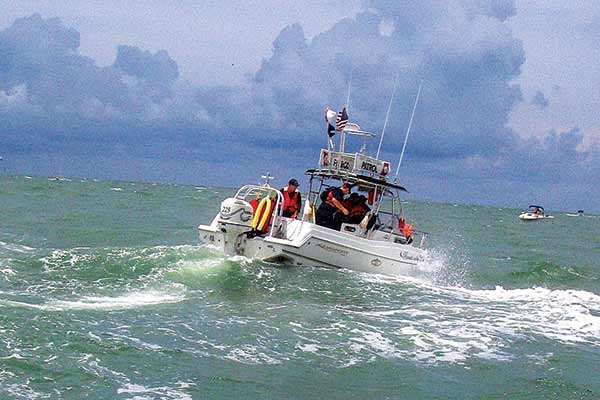
Photo: Trish McGregor
Too much weight forward can lead to a wet ride, or worse.
4. Pay attention to seas astern.
A surprising number of small boats (and also quite a few larger ones) are swamped when a sea comes over the stern. Normally, the top of the stern is lower that the top of the sides in other areas around the boat. This is made more so by a cutout for an outboard. Also, it's often open to the cockpit or interior of the boat, unlike the bow area, which may have at least a small deck or covering to help deflect waves from coming down inside the boat. One common cause of getting swamped, as you might expect, is overloading astern. It's natural to move people and other weight back there because it's wider and seemingly more stable.
Another common cause of getting swamped from the stern is slowing down too quickly, particularly with an outboard. The following wake catches up with your boat and floods over the stern cutout. Normally, the boat should be able to handle this, but if this is coincidentally coupled with a naturally occurring following sea and with too much loading astern, the boat could suddenly take on so much water that it becomes unstable and possibly sinks.
5. Running with following sea requires a skill set very different from those required with other angles of attack.
 When heading into waves, a slight adjustment of speed or heading can prevent pounding. To improve the ride, try backing off the throttle a bit and taking the waves at a slight angle.
When heading into waves, a slight adjustment of speed or heading can prevent pounding. To improve the ride, try backing off the throttle a bit and taking the waves at a slight angle.And, some might say, even a greater degree of care. You must, while keeping lookout all around as you would normally, also keep a watch astern for the oncoming following sea. Often you'll need to throttle up or down to keep the boat in a safe position relative to the sea and to avoid potentially disastrous consequences as it reaches the trough and encounters the next wave. For example, in high seas you don't want to fall over the crest and drop bow first into the trough. If this happens, the bow may dig into the next wave or the boat may slide down, beginning to turn sideways and flipping. If the bow digs down into the sea as it meets the next wave, this could cause catastrophic flooding or cause the boat to lip either to the side or stern over bow or somewhere in between. Usually these things are more likely to occur when you're running too fast for the conditions, but they can also occur, given the right circumstances, at relatively slow speeds.

Photo: Karen L. Miller
In large waves, slowing down can be your best option.
6. It's commonly understood that we should avoid running or even drifting with seas on the beam.
But unfortunately, there are occasions when we need to do this, at least for a short while. If the seas are breaking or very big for the boat, you should figure some other way to handle the situation and not run with seas on the beam. But if it's critically necessary to run for a while with a beam sea, watch the seas very carefully and be prepared to turn into a wave that looks like it's going to break or be large enough to upset the boat's stability. On some boats, you can dampen the rolling and help with stabilization by the way you steer. Turning slightly into or out of the wave, at just the right time and just the right degree, can help keep the boat on a more even keel. Like so much of boat handling, this requires a lot of practice and familiarity with your boat and its characteristics. Learn, but not at the expense of capsizing.
7. Don't travel in limited visibility unless you really need to.
Know what you're doing, have appropriate navigational tools for the conditions, have all of your nav and instrument lights working, know the territory well, travel slow, and keep careful watch for others traveling. This could include boats traveling unlit at high speed and possibly with impaired operators.
8. Never run the boat while impaired.
Have at least one other person to help who is also not impaired. While there are many very good general principles and concepts about small-boat handling (and handling of any boat), there are so many variables that it's difficult to cast anything into cement. Variables can include different types of boats, different types of boat conditions, different types of power configurations, different sea conditions, different weather conditions, different degrees of visibility, different sets of operator knowledge and skills, and much more. So don't take anything I've said here as gospel, and realized that I've hardly scratched the surface as to skills that you need to safely handle a small boat. There are many more issues of equal and greater importance. Go to courses and learn the rules but that's just the beginning (for more on boating safety courses, see www.BoatUS.org).
You need to learn to handle your boat on the water, practicing safely as you learn. Like learning any skills, it takes time. But it's worth it![]()
Tom Neale is a technical boating expert and liveaboard cruiser. For more tips and tactics see Onboard With Tom Neale.
— Published: Spring 2015
